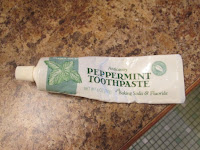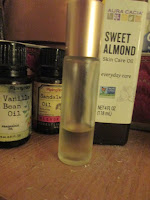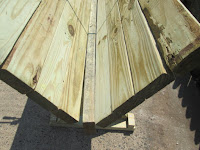Most years, Brian and I celebrate our anniversary in a modest style. For the first few years of our marriage, I'd put on the bodice from my wedding dress, we'd buy a little 4-inch version of our wedding cake, and then we'd go to the park where we got married to eat it. When the bakery stopped carrying small cakes, we started going to Princeton instead and visiting the bakery cafe to order a slice of the same cake. And when the cafe shut down during the pandemic, Brian started baking the cake himself. Our gifts to each other were either small tokens (like the game I made for Brian and the aluminum-foil flower he made for me on our tenth anniversary) or practical items (like the cherry tree we planted for our fourth anniversary, which sadly didn't survive, or the glass-and-silicone lids I got Brian for some of our Pyrex containers on our fifteenth). The biggest celebration we ever had was going shopping at IKEA and having lunch in the cafe.
But this year, for our twentieth anniversary, we decided to splash out a little. We've discovered that one activity we really enjoy is going to a town where we haven't spent a lot of time before and just exploring, wandering up streets and into shops looking at whatever takes our fancy. So, for our anniversary, we decided to carry out this activity on a grander scale by visiting the biggest town on the whole East Coast: New York City.
Although this trip was bound to be much costlier than our usual anniversary outings, we tried not to go overboard. We made no attempt to get tickets to a show, which could easily have cost more than we'd spent on all our previous 19 anniversaries put together. We didn't even plan a visit to a museum, not even the intriguingly named Museum of Illusions or Museum of Sex, which would have cost over $70 for two tickets. Instead, we looked for things we could do at little to no cost within walking distance of Penn Station, thus avoiding any need to find our way around on the subway.
Our first stop (well, second, after the rest rooms at the station) was 9th and 31st, where an article from Beloved City had promised we could find a "magical art installation" called Citrovia. But as it turned out, this article was several years old, so the exhibit was no longer there. Fortunately, we hadn't gone very far out of our way, so we just continued on to the next site on our list: the High Line, a park built on a disused set of former elevated train tracks. It's only about 1.5 miles long, but it has lots to see, including a variety of native plants, some funky art exhibits, and an above-the-fray view of the city.
We also got a look at the neighboring Hudson Yards, which is both a resting spot for the city's trains and an open-air food court. We weren't quite ready for lunch at that point, but we did get a peek at a huge public sculpture in that area called "The Vessel": a series of staircases and landings visitors can explore. The ground-floor level is normally open to the public for free, but it was closed for construction, so we had to content ourselves with snapping a photo or two from outside.Being thwarted by construction continued to be a theme of the trip as morning wore into afternoon. We'd planned to exit the High Line at 16th Avenue and then descend to street level to go visit Chelsea Market, a sort of Bohemian shopping mall with lots of eateries, but the section of the park between 23rd and 16th was closed for maintenance. So we got off at 23rd and wended our way through the streets to Chelsea Market in the wake of a large crowd of students all wearing yellow backpacks with "MLA" on them. (My first thought was "Modern Language Association?", but a quick search showed it referred to Moving Language Ahead, an English course for foreign students that culminates with a trip to an English-speaking country.)
For lunch, we chose a place called Berlin Currywurst, which offered an intriguing-sounding tofu kielbasa. Sadly, the sausage itself was disappointing, a bit mushy and lacking the garlic punch I expect from a proper kielbasa sausage. Also, the bun it was served on (along with some unremarkable sauerkraut) disintegrated about three-quarters of the way through, and Brian's more traditional meat bratwurst sandwich didn't fare any better. So, 6 out of 10 for the sausages, but 10 out of 10 for the accompanying French fries, which had a crisp, golden exterior over tender insides. The only fault I could find with them was that they were perhaps a trifle over-salted, but Brian thought they were just right.
We ate our sausages at a small table, shoulder to shoulder with several Italian students, then spent some time exploring the rest of the shops. We ventured into a fancy bakery, an artists' market, a vintage candy store, a place called Imports from Marrakesh featuring an intriguing assortment of clothing and decor, a quaint delicatessen, and finally a genuine independent bookstore called Posman Books. We browsed through the volumes and found nothing irresistible, but I did drop $5 on a little LED flashlight for my key ring. I'd been looking for something like this anyway, so I took the opportunity to support an independent bookseller and pick up a little souvenir of our trip at the same time.
After reascending to the High Line and continuing down it to the end, we wove through the streets and crossed the bridge to Little Island, an artificial island built out in the Hudson. It's mostly used in the evenings as a live music venue, but it was a fairly interesting place to walk or, more accurately, climb along sloping paths and natural stone staircases. After rambling up and down in the midday heat, we were feeling a little tired, so we stopped into Pier 57—another large, upscale food court—to have a cup of coffee and spend some time in the air conditioning.Refreshed by our rest, we sallied back out and made our way to the garment district, where we strolled up 7th Avenue peeping into shop windows. I slipped into one store just long enough to check the price of a dress I'd seen in the window, which I'd guessed would be too rich for my blood at $278. Apparently I'd failed to account for the Manhattan conversion rate, because the actual price tag read $795, causing me to back carefully out the door and flee before a salesperson could spot me.
The only store we actually explored in detail was the always entertaining Williams-Sonoma, home of pricey kitchen gear. (An amusing and very New York sales clerk at this particular branch described it as a "toy store for adults.") None of the on-sale items appealed to us, but Brian found one thing he thought he could use: a candy thermometer to replace the wildly inaccurate one we have now. Unfortunately, it was a $65 model equipped with Bluetooth, a feature for which we'd have no use whatsoever. So instead, I bought him a more reasonable $29 instant-read thermometer, suitable for a variety of applications, as my anniversary gift to him. (He's already used it once to test the temperature of an ice cream base he's preparing in our new-to-us ice cream maker.)
As the clock ticked past 5pm, we had to decide whether to stay in the city for dinner or head home. Deciding that we didn't want to wait that long to eat, we settled for a quick bite at New York Pizza Suprema right near the train station. Beloved City had described this as the best slice of pizza in New York, but I strongly suspect this isn't true; both the fresh mushroom and the vegan margherita were pretty good, but neither was superior to Brian's homemade pizza. (The crust was nicely crisp on the edges, but a bit soggy in the middle, and the cheese on the vegan slice had an odd, liquid texture, not nearly as good as our homemade vegan mozzarella.) Still, it was unquestionably an authentic New York experience, and at $12.50 for both slices, undoubtedly the cheapest meal we could have expected to enjoy in the city. After this light supper, we roamed just a few blocks farther north before heading back to the station and home again for cake.
Although we hadn't officially made a budget for this trip, my private goal was to keep the entire excursion under $200: $10 for each year of our marriage. As it turned out, we met this target with plenty of room to spare. Our expenses were:
- Two round-trip fares on NJ Transit: $64.40
- Lunch at Berlin Currywurst, including tip: $31.30
- Mini flashlight from Posman Books: $5.44
- Tip for a busker playing the erhu on the High Line: $2
- Coffee at Pier 57, including tip: $6
- Thermometer from Williams-Sonoma: $29.34
- Dinner at NY Pizza Suprema: $12.50
- Parking in New Brunswick, which saved us a long walk at the end of a busy day: $16.00
- TOTAL: $166.98
Even if you add in the $21.27 Brian spent on my anniversary gift (an amusing board game called Cat Lady) and the groceries we bought for our anniversary cake, our celebration still easily rings in at under $200. It's more than we'd usually spend for a one-day outing, but when you consider that Arthur Frommer's 1957 feat of seeing Europe on $5 a day would cost at least $125 today—or $250 for two people—New York on $167 a day doesn't sound so bad.























